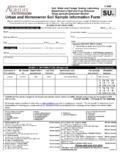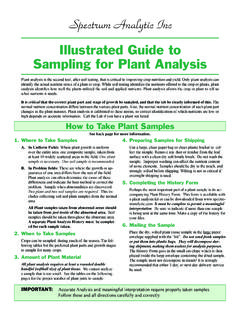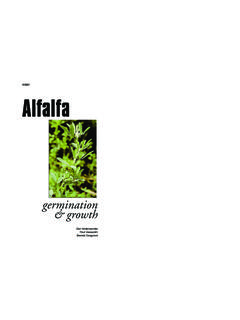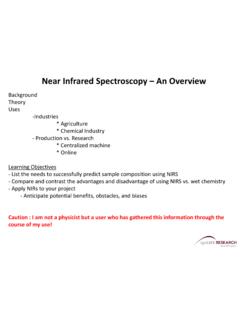Transcription of soil test interpretations recommendations jan 2005
1 1. soil TEST interpretations . AND. recommendations HANDBOOK. Originally written 1983. By Daryl D. Buchholz Revised 5/2004. Contributors: James R. Brown Deanna K. Crocker John D. Garrett Roger G. Hanson John A. Lory Manjula V. Nathan Peter C. Scharf Howell N. Wheaton University of Missouri College of Agriculture Division of Plant Sciences 2. TABLE OF CONTENTS. Page No. INTRODUCTION 1. NITROGEN 6. AVAILABLE PHOSPHORUS ..13. EXCHANGEABLE POTASSIUM ..20. soil ACIDITY AND LIMESTONE ..27. EXCHANGEABLE MAGNESIUM 32. EXCHANGEABLE CALCIUM ..34. SULFUR ..35. MICRONUTRIENTS (ZINC, IRON, MANGANESE, COPPER).
2 37. CATION EXCHANGE CAPACITY .40. APPENDIX ..41. CROP CODE 201. Southern peas ..42. CROP CODE 202. Watermelon ..43. TABLE A. Double crop yield goals .44. 2. 3. List of Tables Table No. Page No. I. Nitrogen rate adjustments based upon soil texture, organic matter, and time of major crop growth 9. II. Equations for determining nitrogen requirements on forage crops 10. III. Nitrogen values for use in recommending N fertilizer for row and small grain crops 11. IV. Equations for determining nitrogen requirements of row and small grain crops 12. V. Bray I soil test interpretations and ratings 15.
3 VI. Phosphorus removal and desired Bray P-I soil test level 16. VII. Definitions of interpretive ratings for phosphorus and potassium soil tests 18. VIII. Fertilizer P2O5 rates required to build Bray P-I soil test level to the desired level in 4 or 8 years 19. IX. Potassium soil test interpretations and ratings 23. X. Potassium removal and desired exchangeable potassium level 24. XI. Fertilizer K20 rates required to build exchangeable potassium soil test levels to 160 + 5 (CEC) in 8 years 26. XII. Fertilizer K20 rates required to build exchangeable potassium soil test levels to 220 + 5 (CEC) in 8 years 26.
4 XIII. Desired soil pHs range for crops in Missouri 29. XIV. ENM requirements to increase the soil pHs to range based upon soil pHs and neutralizable acidity 30. XV. ENM requirements to increase the soil pHs to range based upon soil pHs and neutralizable acidity 30. XVI. ENM requirements to increase the soil pHs to range based upon soil neutralizable acidity 31. X VII. Effective magnesium requirements to correct soil magnesium 33. XVIII. Ratings for sulfur status of soils 35. XIX. Suggested sulfur application rates when the soil sulfur status is low dependent on sulfate-sulfur soil test and cation exchange capacity 36.
5 XX. Ratings for DTPA extractable micronutrient soil test levels 37. 3. 4. LIST OF FIGURES. Figure No. Page No. 1. MP-188 soil Sample information Form, Front 3. 2. MP-188 soil Sample information Form, Back 4. 3. MP-189 soil Test Report Form 5. 4. 1. INTRODUCTION. This handbook contains information relating to soil test interpretations , and fertilizer and limestone suggestions used by the University of Missouri soil Testing Service. This information is used with chemical soil tests currently used by the University of Missouri soil testing labs. This handbook is designed to facilitate individuals familiar with Missouri's soil testing program in deriving interpretations and suggested treatments based upon soil test levels.
6 Major contributors to this handbook include Daryl D. Buchholz, James R. Brown, Roger G. Hanson, Howell N. Wheaton, John D. Garrett, Robin R. Rodriguez, Don Backfisch, John Lory, Peter Scharf, and Manjula Nathan. Figures 1, 2, and 3 are the front and back of the soil information Form (MP-188) and the soil Test Report Form (MP-189) currently being used. Various other sources should be consulted for more in-depth discussion of soil test interpretations and information on Missouri's soil testing program. These sources include: Fisher, T. R. 1974. Some Considerations for interpretations of soil tests for Phosphorus and Potassium.
7 Missouri Agricultural Experi- ment Station Research Bulletin No. 1007. Brown, J. R., R. G. Hanson, and D. D. Buchholz. 1980. interpretations of Missouri soil Test Results. University of Missouri Agronomy Department Miscellaneous Publication 80-04. Brown, J. R. and Robin R. Rodriguez. 1982. soil Testing in Missouri. University of Missouri Extension Circular 923. Computer programming assistance has come through Deanna Crocker, Michael Hess, Ken Kuebler, Mark Gardner, and Richard Ahrens. The author would also like to thank the many members of the Agronomy Department who have been involved in various ways in helping to establish meaningful soil test interpretations and suggested fertilizer and limestone application rates.
8 2. Nitrogen The soil Test Nitrogen is a mobile nutrient in the soil . Nearly all soils in Missouri require nitrogen for optimum production of crops requiring nitrogen uptake. The soil test used to estimate the nitrogen-supplying power is the organic matter test. Some nitrogen adjustments are also made on the basis of soil texture and time of year that the major portion of the crop growth takes place. Table I outlines the nitrogen-supplying power of soils for nearly all row crops and small grains. The Rating System Soils are not rated on the basis of organic matter content.
9 This is because rapid changes in organic matter do not occur under normal crop management. As can be noted, soils containing higher amounts of organic matter generally are capable of releasing higher quantities of nitrogen. The recommendations A. Forages Nitrogen recommendations on forage crops generally make no adjustments on the basis of organic matter. Legumes fix their own nitrogen and, therefore, generally, do not have recommendations for additional nitrogen fertilizer. Table II lists the nitrogen recommendation equations used for all forage crops that do need nitrogen.
10 Crops not listed have no nitrogen requirement. B. Row Crops and Small Grains Nitrogen needs for a crop are determined on the need to produce the vegetation and grain portions. The crop needs for nitrogen on a per unit basis are given in Table III. Total nitrogen needs are calculated using the equation: NR = (Vm) (Nv) + (Yg) (Ng). Where: NR = total nitrogen requirement Vm = pounds of vegetative material per acre Nv = pounds nitrogen per pound of vegetative material Yg = Yield goal Ng = pounds of nitrogen per yield unit (grain). 2. 3. Nitrogen requirements (NR) minus the nitrogen-supplying power of the soil (Table I).








